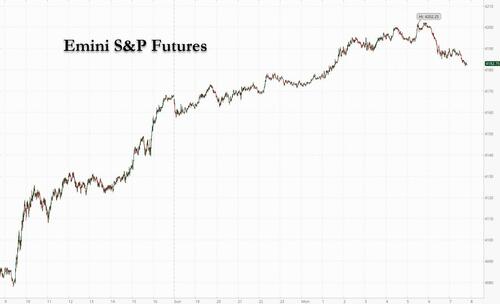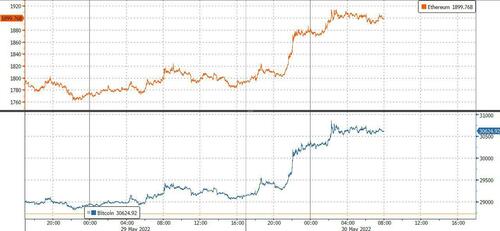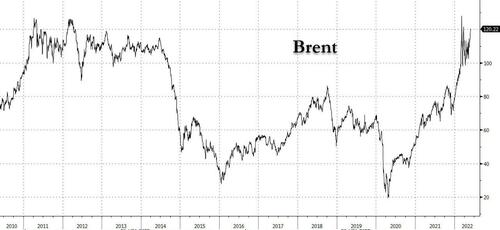“Risk Is Back In Business”: Futures, Bitcoin, Oil Jump As China Eases Covid Curbs
While US cash markets are closed today, the rest of the world – as well as US futures – are busy levitating amid renewed optimism that China has finally managed to contain its latest Covid breakdown after Beijing said the outbreak is now under control and the country eased more virus curbs. The upside momentum was also boosted by the best week on Wall Street since November 2020, which was catalyzed by speculation that the Fed will pause its hiking plans in September (and then proceed to ease once the recession is official). At 730am ET, emini futures trade 30 points higher or 0.70%, while Nasdaq futures jumped 1.2% higher. Oil climbed in response to the easing of Chinese lockdowns and as the European Union worked on a plan to ban imports of Russian crude, while the dollar fell for a third day.
While US markets are closed, the S&P 500 wiped out its May losses and snapped a string of seven weekly declines as institutional investors rebalanced portfolios into the end of the month.
“Risk is back in business it seems,” said AJ Bell investment director Russ Mould. “A reopening of key economic hubs in China and suggestions the US Federal Reserve might slow the pace of interest rate hikes are helping to boost sentiment, at least in the short term.”
Traders will be pondering whether the bottom of the selloff is near as investors have been buying the dip after one of the worst starts to the year for equities. However, as Bloomberg notes, a wall of worries remains from hawkish central banks underscoring fears of a recession, escalating food inflation from the war in Ukraine and China’s lockdowns stunting economic activity.
“We are in the middle of a bear-market rally,” said Mahjabeen Zaman, Citigroup Australia head of investment specialists, said on Bloomberg Television. “I think the market is going to be trading range-bound trying to figure out how soon is that recession coming or how quickly is inflation going down.” She added that Treasury yields are set to peak this year.
European bourses enjoyed a fourth day of gains, extending their longest winning streak since late March and driving the Stoxx 600 index to the highest in more than three weeks. Luxury stocks outperformed Monday as China’s reopening plans boosted sentiment. The Euro Stoxx 50 rose 0.9%, with Spain’s IBEX lagging, dropping 0.2%. Consumer products, tech and travel are the strongest-performing sectors. Shares in European crypto stock rose as the price of Bitcoin jumped to almost $31,000, as risk-on appetite returns with China easing Covid restrictions.Bitcoin was up 5.2% and trades at $30,660.69 as of 730am ET, set for its biggest gain in two weeks. Stocks such as Northern Data soared as much as 5.1% Argo Blockchain 2.6%, Arcane Crypto +6.3%, Safello Group +2.8%.
Spanish inflation unexpectedly quickened, while regional German inflation data also pointed to a concerning picture ahead, denting hopes that the eurozone’s record inflation surge has peaked and piling more pressure on the ECB to act. German bunds fell the most in two weeks.
Equities across Asia Pacific rose as China rolled back some strict pandemic-triggered restrictions and after US 10-year Treasury yields capped a third week of declines. The MSCI Asia Pacific Index extended gains to 2.1%, the biggest jump this month, led by consumer discretionary and tech shares. Benchmarks in Japan and Taiwan advanced the most. Chinese shares including tech names climbed as local authorities eased curbs on movement in key cities after virus cases fell. The Asian measure is close to erasing losses for May, which would mark its first monthly advance this year as a reopening of China’s economy boosts growth prospects for the region. That, along with stabilizing global bond yields, have supported regional shares. Still, concerns about slowing global growth and high inflation remain, with foreign investors dumping Asia’s tech-heavy markets this year. With US markets closed for a holiday Monday, traders are turning their attention to China’s purchasing managers’ index figures for May, scheduled for release Tuesday.
“The focus will be on how much the May data has improved from April, given the number of cities under some sorts of lockdown” has fallen to 26 from 44, accounting for 20% of national GDP, Charu Chanana, a market strategist at Saxo Capital Markets, wrote in a note.
European bonds tumbled after Spanish inflation came in hotter than expected, while regional German inflation data also pointed to a worrisome picture ahead, with more CPI prints out of the euro area due later Monday and Tuesday. Money markets raised ECB rate-hike bets, pricing 114 bps of hikes by the end of the year. Bunds yield curve bear-flattens, 5y underperforms, cheapening ~9bps to near 0.75%. Peripheral spreads widen to Germany with 10y BTP/Bund widening 3bps to ~195bps. Gilts follow suit, with the 10-year yield up some 6bps to 1.975%. US 10-year note futures decline 12 ticks to 119-24+ with cash Treasuries closed for US holiday.
In FX, the dollar slipped for a third day versus major peers as havens lost their appeal amid the improved mood. The Bloomberg dollar spot index fell 0.2%. JPY and CHF are the weakest performers in G-10 FX, SEK and NOK outperform. China’s yuan outperformed after the nation reported fewer Covid-19 cases in Beijing and Shanghai. China’s reopening moves prompted a gauge of emerging-market stocks to rise to the highest since May 5.
Bitcoin posted its biggest gain in two weeks, climbing close to $31,000, with ethereum regaining $1900.
In commodities, oil climbed as China eased anti-virus lockdowns and the EU worked on a plan to ban imports of Russian crude; Brent is heading for its sixth monthly gain, the longest winning streak since April 2011; US gasoline prices surged to another fresh record. WTI drifted 0.5% higher to trade above $115 while Brent rose above $120.
Spot gold is off best levels, up some $4 to $1,857/oz. Most base metals trade in the green; LME nickel rises 6.5%, outperforming peers.
There is nothing on the US calendar due to the Memorial Day holiday.
DB’s Jim Reid concludes the overnight wrap
Everything was going so well at lunchtime on Saturday. In my big 36-hole tournament I was poised and ready to pounce just outside the top ten. However I then had one of my worse rounds for years as my back seized up and then, immediate after, watched Liverpool lose the biggest match of the season. I went to bed wondering if Liverpool could ever recover from this and whether my back would ever allow me to play the type of competitive golf I want to again. It was a low moment. Then in another competition on Sunday my back eased and I shot my best competition round for as long as I can remember. Annoyingly I finished second and missed out on the cup. A bit like Liverpool.
It’s going to be a bit of a stilted week with the US off for Memorial Day today and the UK off on both Thursday and Friday to celebrate the Queen’s Platinum Jubilee. However there’s lot of important data from both a growth and inflation perspective this week with the monthly jobs report from the US (Friday) and a slew of May CPIs from Europe. Industrial activity will be in focus too with the Chicago PMI, the Dallas Fed manufacturing activity index (Tuesday), the ISM index (Wednesday) and several European PPIs due.
On Wednesday, markets will also be especially focused on central banks with the start of the Fed’s balance sheet run off, the BoC decision and the Beige Book release. In Asia, next week will be packed with data for Japan and PMIs from China will be due.
Given the recent rally in bond markets, one of the most important prints could be German inflation today with estimates slightly higher than last month which on one measure was the joint highest since 1950. We’ll get the regional prints this morning and then the country wide aggregate at lunchtime. On the EU harmonised reading consensus is at 8.1% up three tenths from those record levels. As we go to print the NRW region in Germany has seen the YoY rate climb four tenths from last month to 8.1%. France, Italy and the Eurozone sees their CPI releases tomorrow.
Producer prices will also be released across the continent, with April PPI due from Italy (today), France (tomorrow) and the Eurozone (Thursday). Finally, labour market indicators will be released throughout the week for Germany (tomorrow), Italy and the Eurozone (Wednesday).
Over in the US, all roads lead to payrolls on Friday with our US economists projecting gains of 325k vs last month’s 428k reading that came in above of the median estimate of 380k on Bloomberg. The JOLTS and ADP reports will be due on Wednesday and Thursday, respectively. The JOLTS report is our favourite for looking at labour market tightness but it is a month behind the less useful payroll report.
Another important set of indicators will come for industrial activity, including the Chicago PMI and the Dallas Fed manufacturing activity index tomorrow, the ISM manufacturing index on Wednesday and April factory orders on Thursday. These follow misses on PMIs, the Richmond index and the durable goods orders last week, so markets will be paying attention as to whether these metrics will come in softer than expected as well. Finally, Conference Board’s consumer confidence index, tomorrow, will be assessed in conjunction with the labour market data to gauge the strength of the consumer.
From central banks, investors will be awaiting this Wednesday when the Fed is due to start its balance sheet run off in order to gauge the preliminary impact on the markets. Elsewhere, the Bank of Canada’s decision will also be due on Wednesday, following a +50bps move at the last meeting on April 13th. Analysts are expecting another 50bps. Finally, the Fed will also release its Beige Book that day and its insights about current economic conditions will be digested together with the other timely US indicators. In speakers, this week, similar to last, will be packed with those from the ECB. Their views in light of the week’s CPI prints will be of great importance. Fed speakers are detailed alongside those from the ECB and all the key data releases in the day-by-day calendar at the end.
In Asia, the highlight will be May PMIs for China released tomorrow and Wednesday and much attention will be paid to the growth dynamics after dismal industrial production and retail sales numbers released two weeks ago.
Talking of Asian, stock markets are edging higher at the start of the week following Friday’s gain on Wall Street coupled with a weaker US dollar and fresh stimulus from Beijing. The Nikkei (+1.97%) is leading gains regionally with the Hang Seng (+1.90%) also significantly higher. Over in mainland China, the Shanghai Composite (+0.31%) and CSI (+0.44%) are modestly up after the Shanghai administration announced that it would remove ‘unreasonable curbs’ on businesses and manufacturers from 1 June to stimulate sagging growth. At the same time, the city unveiled fresh economic support measures by offering tax rebates for companies and allowing all manufacturers to resume operations from June. Among the 50 policy measures in eight categories announced by Shanghai officials the city will cut some purchase taxes, issue more quotas for car plates, and subsidise electric vehicle purchases.
Outside of Asia, equity futures in the DMs point to further gains with contracts on the S&P 500 (+0.46%), NASDAQ 100 (+0.81%) and DAX (+0.46%) trading higher.
Oil prices are higher in Asia with Brent futures up +0.53% to $120.06/bbl, as I type. Over the weekend, EU diplomats failed to come to an agreement on the EU’s proposed ban on Russian oil ahead of a 2-day summit with EU leaders starting today. Meanwhile, OPEC+ are set to meet on Thursday to discuss their production policy for July.
Turning to a recap of last week now. The S&P 500 finally managed to break its nearly two month long losing streak, gaining +6.58% (+2.47% Friday) over the week. Consumer discretionary stocks led the way, gaining +9.24% (+3.47% Friday), after being the worst performer YTD. The outperformance was twofold, one was better earnings news from discount retailers this week, the second was a continued reappraisal toward a softer Fed policy path, which saw cyclical stocks outperform in general. Nevertheless, all sectors were higher, bringing the S&P 500 to -12.76% YTD. US indices were green across the board, including the NASDAQ (+6.84%, +3.33% Friday), the Russell 2000 (+6.46%, +2.70% Friday), FANG+ (+7.83%, +3.15% Friday) and Dow Industrials (+6.24%, +1.76% Friday).
European stocks lagged slightly, as the drum beats on toward more ECB tightening, but nevertheless were also higher over the week, with the STOXX 600 gaining +2.98% (+1.42% Friday) while the DAX and CAC were +3.44% (+1.42% Friday) and +3.67% (+1.64% Friday), respectively.
On the rates side, Treasury yields retreated in light of the continued growth fears and potential for a shallower Fed path, with terminal fed funds rate pricing closing below 3%. Regular readers will know I don’t think the Fed is set to pause, or that terminal rates that low will ultimately rein in inflation at current levels. So we will see. Indeed, Core PCE in the US from April was released Friday, printing at 0.3% MoM, in line with expectations and showing no signs of deceleration. Nevertheless, 2yr Treasury yields fell -10.5bps (flat Friday), while 10yr yields were -4.3bps lower (-0.9bps Friday) in one of the least volatile weeks for Treasury trading this year. In Europe, 2yr bund yields increased +1.1bps (-0.3bps Friday) while 10yr yields gained +1.9bps (-3.5bps Friday), as the consensus behind a July liftoff and positive policy rates by year end grows among ECB officials.
Elsewhere, brent crude climbed +6.12% (+1.74% Friday), while the dollar came down from its lofty heights, with the broad dollar index retreating -1.45% (-0.17% Friday).
Tyler Durden
Mon, 05/30/2022 – 08:08
via ZeroHedge News https://ift.tt/ijBQ1Sr Tyler Durden


